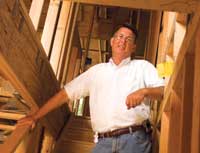Homemade Mortgages
Because no institution was willing to give mortgages to Trenton’s poor, The Martin House created its own. The median income for Trenton’s households is $31,074 compared to the U.S. national median of $46,000. Of the 120 mortgages granted, 65 have been retired. If a problem arises, the difficulties are smoothed over by The Martin House, McCormick says.
“Most of the recipients realize the gift they are given,” Kim says.
The homeowner of record must attend at least 50 hours of classes in carpentry, plumbing, and electricity. The Martin House wants the homeowner to be able to meet the challenges of maintaining a home as they arise.
The classes also help the homeowner understand what went into the construction of a home. McCormick has seen bonds and friendships formed at the classes as people work together while learning to frame a wall or hang drywall. “They get a kick out of it,” he says.
When BCHT homes are nearing completion, Kim hosts “trim weekends,” when doors, trim and cabinets are put into place by contractor customers and friends of Kim, who work for one to three days at no charge, followed by a picnic. “It’s amazing. All I have to do is ask. I don’t think I have ever been turned down for help,” he says.
Although some materials used for BCHT homes are sold to The Martin House through Hamilton Building Supply, the dealer sells the materials at a low price and floats the bill, interest free, while The Martin House awaits funding. The organization’s primary source of revenue comes from The Martin House Foundation fundraising branch.
Kim procures other goods himself. Friends, business associates and people he knows in the community will let him know of a new washer and dryer, for instance, that have a slight defect. He is quick to grab hold of them and have them donated to The Martin House. The same goes for building materials and millwork, such as windows and doors.
Kim also oversees the bills for BCHT projects, making sure they are on budget and running smoothly. “In the field, he has been able to coordinate a top-quality project at a very low price,” McCormick says. “That’s a huge asset.”
Kim has always been a hustler, according to his brother Keith. In his teens, Kim spent nearly every day at Hamilton, which their father Jesse Coleman Jr. and his brother, Earle, bought in 1964. How did Kim get to work after school each day? By hitchhiking, of course. Before that, he had a bike route delivering eggs in Trenton’s tough streets.
Today, Hamilton Building Supply operates on a 12-acre yard serving customers within a 12-mile radius of Hamilton Township. About 60% of its customers are remodeling contractors, the largest customer being C.M.M. Builders, more than 100 miles away in the oceanside vacation town of Wildwood Crest, N.J. Last year, the dealer pulled in sales of $28 million.
“Kim worked every chance he could, and he set the standard for the family,” Keith says. “He’s the type of guy that works really hard and plays really hard.”
Early in the relationship, when Kim first came on board as a volunteer for The Martin House, he questioned whether McCormick’s goal was completely worthy given Trenton’s blighted streets. He thought: if these new homes were being built in less-than-admirable urban conditions, surrounded by filth and decay, would they not share the same fate?
“I would see a really nice home, with a home next to it with garbage in the front. You don’t really need money to be clean,” Kim explains. McCormick told him that every so often, the cycle of despair needs to be broken.
Kim has since revisited some of the first homes he worked on 11 years ago. “They look just as nice, if not nicer, than when I left them,” he says.
–Andy Carlo



